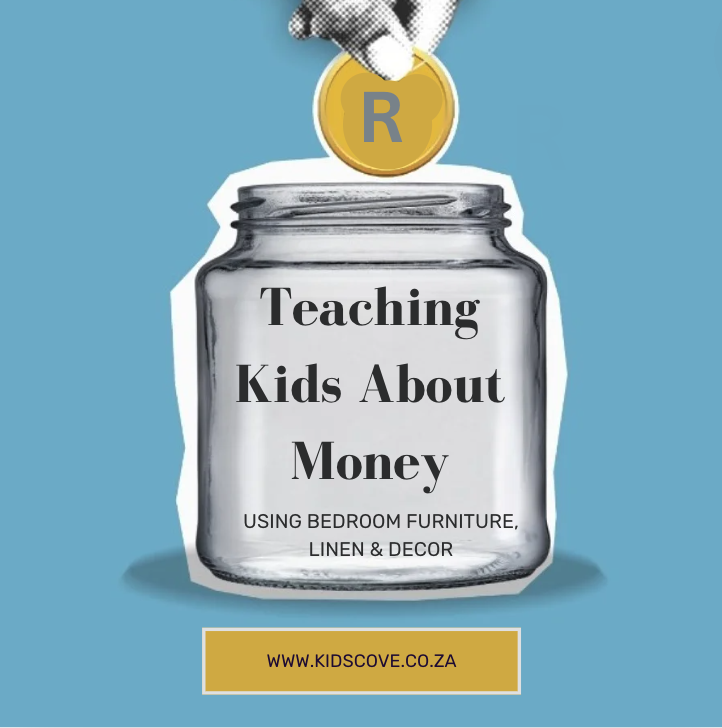Teaching kids about money

Money management is a vital skill that everyone needs to learn, and starting early can set kids up for financial success in the future. As the owner of a furniture, decor, and linen store, I’ve seen firsthand how understanding the value of money can influence buying decisions. When we had a physical store, parents would bring their kids in with them and they would stress test every piece of furniture , but you can teach them more than just quality assurance, you can teach them why that’s good for their pockets. Treating your child to a new bed can be a fabulous opportunity to teach them about money.
I want to share some practical tips on teaching your kids about money, drawing from the world of kids furniture, decor and linen. There’s a lot you can teach them whilst creating rooms to love:
1. Let our furniture be the lesson to understanding value:
* Real-Life Costs: In our online store, you can find a wide range of furniture pieces, each variation with its own price tag. Use our products to teach your kids about the different factors that influence cost, such as material quality, design, finish, craftsmanship and service. Explain how a sturdy, high-quality bed or pure cotton duvet cover might cost more because of these factors.
* Saving for Special Items: Just as we save up for a big purchase like a new bunk bed or a luxurious rug, kids can learn the importance of saving for items they want. If you’re looking to revamp their room, then create a savings goal chart with them and encourage them to set aside a portion of their allowance to contribute to making this happen. Not only will you get their literal buy-in, you’ll make sure they understand that making big and costly decisions need to be thought through.
2. Budgeting for big things:
* Creating a budget: Demonstrate how budgeting works by showing them how you manage expenses at home. For example, explain how you allocate a budget for different categories—like schooling, transport, house maintenance, rent and utilities and the stuff they really understand like pocket money, snacks, hobbies and entertainment. Then, help them create a simple budget for themselves, like saving for a game or toy. Teach them to always set some aside for savings.
* Spending wisely: Just as we carefully select which products to stock in our store based on customer needs and trends, teach your kids to think critically about their purchases. Encourage them to ask themselves if they really need something before spending their money, and help them understand the concept of opportunity cost—what they might be giving up if they spend their money now. This won’t happen overnight, but it’s where repetition becomes important. And don’t forget, they’re learning by watching you, so make sure you’re spending wisely and teaching by example.
3. Earning money:
* Chores and allowance: Many of our store’s products are the result of hard work, from design to delivery. Teach your kids that earning money through chores or small jobs is similar to how we earn money from selling furniture or how you work hard to be able to buy them the furniture in their rooms. Help them create a list of chores they can do to earn an allowance and link their earnings to real-world tasks and responsibilities.
* Get them thinking about how to make their own money: Share stories of how small businesses start and grow, perhaps you’ve been on your own entrepreneurial journey to draw from. Our business has been going for almost 2 decades and we have built up a loyal customer base. To do this we keep working on consistency in quality and customer service. Encourage your kids to come up with their own small business ideas, whether it’s baking cookies or mowing lawns. This hands-on experience can teach them about earning, managing, and investing money.
4. The value of quality and longevity:
* Investing in quality: We cannot emphasise enough the long-term benefits of investing in high-quality products. Teach your kids that sometimes spending a bit more on something durable and well-made can be more cost-effective in the long run. Compare this to buying cheaper, lower-quality items that might need to be replaced more frequently.
* Looking after our things: Just as we take care to create furniture that lasts, teach your kids the importance of taking care of their belongings. Explain how they can look after their possessions and save money or pass it on to someone who can get a second life out of it in the long run.
Teaching your kids about money doesn’t have to be complicated. By using real-life examples, you can help them understand the complexity of being financially astute. As they learn to manage their own money wisely, they’ll carry these lessons into adulthood, helping them make informed financial decisions throughout their lives.
Beds may grow on trees (in a sense) , but like my mother always said, money doesn’t!